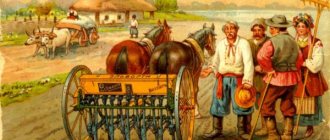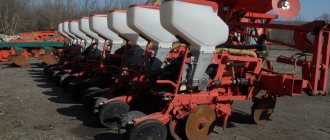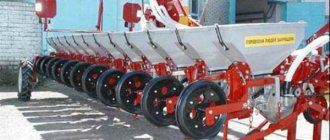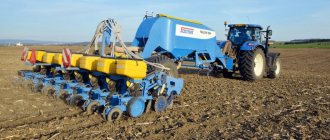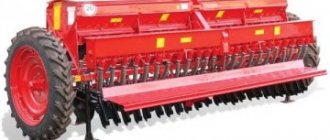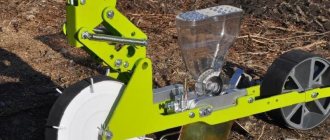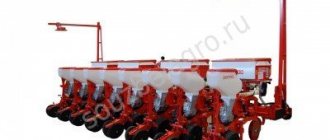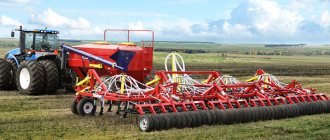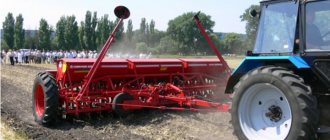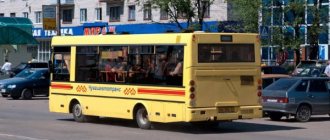History of the creation of the SUPN-8 seeder
In 1874, entrepreneurs from England, Thomas and Robert Elvoroti, on rented premises, founded a workshop in Elisavetgrad (today Kirovograd) for the production, repair and adjustment of imported seeders.
Later, due to increased demand, the brothers began building their own plant to produce horse-drawn seeders. The production of butter churns, crushers, mills and other equipment was also mastered.
By 1917, the plant already employed more than 7 thousand people. A large range of agricultural equipment for tillage, seeders, dryers and grain crushers was produced. Between 1874 and 1917, 50 awards were won at international agricultural exhibitions. There were representative offices in 52 cities, in Russia and abroad, for example in New York and London.
After the revolution of 1917, the enterprise was nationalized and renamed.
During the Second World War, during the fighting, it was almost completely destroyed. After the liberation of Kirovograd, its intensive restoration began and by the end of 1944, 2.5 hundred seeders had already been manufactured, and ammunition was also manufactured.
By 1950, the plant was almost completely restored. The designers have created 45 different types of sowing equipment, and the production level has exceeded the military level.
Over the next 25 years, the plant constantly increased and improved production. By the end of the 70s, the plant produced up to 100 thousand sowing machines. At the same time, the construction of new workshops and the re-equipment of the enterprise are taking place, thanks to this there is capacity for the production of a new model of the SZ-3.6 seeder.
In the 80s, 90 thousand seeders rolled off the assembly line every year. In the 90s, 12 new sowing complexes and other equipment were introduced.
In 2003, the company changed its name to the Ukrainian “Chervona Zirka”, which translated into Russian sounds as before “Red Star”. In 2004, the company updated its model range. Many seeders developed back in the mid-70s, like the hero of our story, the SUPN-8 seeder, are giving way to more modern counterparts.
Equipment brands
Today, many companies produce such seeders, both domestic and foreign. If you wish, you can purchase a model designed for any tractor power. Such equipment is available for sale today, including for private households. For example, if necessary, you can purchase a corn seeder for a walk-behind tractor. Of course, companies specializing in the production of agricultural machinery also produce similar equipment designed for attachment to mini-tractors.
If we talk about brands, then the most popular among farmers and employees of agricultural holdings at the moment are, for example, seeders:
- "Gaspardo";
- "Amazon."
The equipment of these particular manufacturers allows planting corn as quickly as possible and with minimal losses. Also, seeders of such brands as John Deere (USA), Lindselmash (Belarus), and Krasnaya Zvezda (Ukraine) received very good reviews from consumers.
Technical characteristics of the SUPN-8 seeder
- The method of aggregation with a tractor is mounted;
- Weight – 1180 kg;
- Productivity – no more than 5 ha/h;
- Required traction class – from 1.4
- Capture – 5.6 m;
- Row spacing – 0.7 m;
- Operating speed – from 6 to 10 km/h;
- Seed depth – from 40 to 120 mm;
- The seeding rate is from 25 to 150 thousand units per hectare.
Operating principle of the SUPN-8 seeder
The mechanism of the fertilizer sowing apparatus, and specifically the sowing discs and spring augers, are driven by a transmission that is driven by the rotation of the support wheels.
Transmission of the support-drive wheel.
The seeder cover has a horseshoe-shaped cavity in which a vacuum is created. This is done using a fan driven by a hydraulic motor powered by the hydraulic system of the tractor. The degree of vacuum in the cavity is controlled using a valve with a membrane pressure control mechanism.
Seeds from the intake hopper are sucked onto the holes of the seeding disc located in the discharged area and sent to the discharge area. Excess stuck seeds are removed using a special fork installed in the intake hopper.
When the seeds in the holes of the disk move from the discharged zone to the zone of normal atmospheric pressure, they come unstuck and fall into the furrow formed by the heel of the coulter.
Spring augers with right and left winding transport mineral fertilizers from a separate bunker to the funnels. Dispersers installed at the entrance funnels distribute the flow through oscillatory movements, evenly distributing fertilizer in the furrow.
With the help of harrows, furrows with applied fertilizers and seeds are covered with soil. Press wheels run along closed furrows, compacting the soil above the furrows and creating conditions for moisture to be drawn towards them.
The working process
Using a vacuum, seeds are captured by rotating discs from the intake chambers of the sowing units and sent to the coulters. Dosed fertilizers also come here.
Skid-shaped openers form two grooves for separate sowing of seeds and fertilizers, and harrows cover them with soil. The soil is compacted above the furrows using compaction rollers. The trails level the field topography behind the coulters and the row areas are covered with a mulching layer of soil.
If the movement of seeds in the controlled area of the sowing device stops (when the vacuum decreases, the disk stops, the coulter becomes clogged, etc.), the sound signal turns on and the number of the failed device lights up on the indicator panel.
If the seed level in the bins becomes unacceptable, a sound signal sounds briefly and a red lamp lights up.
Video demonstrating the operation of SUPN-8
Structure of the SUPN-8 seeder
The frame of the SUPN-8 seeder is equipped with an automated hitch. In the working position, the frame with all mechanisms rests on two pneumatic wheels, which, in addition to their supporting function, act as a drive for the mechanism of grain and fertilizer sowing devices.
A fan is installed in the center of the frame, creating a discharge zone in the system; it is driven by a hydraulic motor powered by the tractor’s hydraulics. Two folding markers are attached to the edges of the frame. At the rear of the frame, 8 sowing units are installed on special suspensions.
Such a section consists of a housing with a container for seeds, it contains a pneumatic sowing mechanism, and the section also has a coulter, a roller, a harrow and a train. The section body is divided into two cavities by a sowing disc with holes around the entire circumference. One of the cavities is filled with seeds, and air is pumped out of the other using a fan through a special air duct.
Seeds, trying to get into the cavity with a rarefied atmosphere, are sucked to the holes of the sowing disk and transported to the bottom of the housing, to an area where there is no vacuum. There, the seeds fall out of the disc holes and fall into the furrow made by the coulter.
Seeding unit with coulter, harrow and chain train.
A scraper installed in the cavity with seeds cleans the disk from excess, adhered grains, which ensures single seed sowing. Seeding discs for the SUPN-8 seeder are supplied in two sets, with 14 and 22 holes, the diameter of which can be 3 and 5.5 mm.
Types by design
In this regard, today there are mainly two types of corn seeders:
- mechanical;
- pneumatic.
The first type of equipment is currently considered somewhat obsolete. Some foreign companies have even stopped producing such seeders. The main disadvantage of mechanical structures is that to change seeds, which have unequal sizes for different varieties of corn, or to adjust row spacing, the entire working element must be removed. Moreover, you have to spend a lot of time on this procedure.
More modern pneumatic seeders do not have this drawback. Such equipment saves time, increases productivity and, as a result, reduces costs. In addition, a feature of such corn seeders is often that they allow fertilizers to be added to the soil simultaneously with planting material.
The disadvantage of this technique is primarily its high cost. Also, seeders of this type often work ineffectively in fields with problematic soil. In some cases, for example, they cannot be used in areas where the roots of plants grown last season remain in the ground.
Operation of the SUPN-8 seeder
Before operation, it is necessary to configure the seeder for the crop being sown and the method of moving the tractor along the marker. The sowing depth is regulated by the position of the coulter, which is changed by moving the cotter pin into the holes of the link. Changing the position by one hole changes the depth by 1 cm.
The seeding rate can be adjusted by changing the seeding disc, as well as by selecting the gear ratio of the drive mechanism, which has 45 modes. A complete list of modes with descriptions is presented in the operating instructions.
The SUPN-8 seeder is used by many large and small farms, despite the fact that it has been out of production for several years. It has its pros and cons; the farmers themselves will tell us more about them.
Reviews:
- I have been sowing SUPN-koi sunflowers for a long time, the seeds are imported and small, so the most common problem in my practice is that it sucks in 2-3 grains at a time, and as a result there is a strong overconsumption of seed material, and the seedlings are very thickened. We tried to make homemade discs with a hole size of 2.5 mm, so the grains began to get stuck in them, and sifting was obtained. In general, it’s a hassle and not a job.
- My opinion is that if the seeder frame is not deformed and does not have mechanical damage to the aluminum parts, everything else can be repaired even in the field, using welding and a grinder. If the opener is worn out, you can weld it on, but it’s easier to replace it; it costs a penny. The lack of vacuum will be corrected by replacing the linings and bushings. There is nothing fundamentally broken in this unit!
So let’s conclude that the SUPN-8 seeder, due to its affordability, simplicity and maintainability, is quite suitable for a beginning farmer. Of course, if it had met all the requirements of modern farmers, it would not have been discontinued. But for its time it was quite a worthy unit.
Its main drawback is its inability to work with small seeds; farmers complain about this problem most often. The scraper does not cope with its duties, missing several stuck grains, resulting in a large overconsumption of seeds. Or screenings occur due to them getting stuck in the holes of the disk.
Main types by method of use
This type of equipment can be used for planting corn seeds:
- trailed;
- mounted
In the first case, the corn seeder is, in fact, a separate device that moves on its own wheels. Mounted seeders are directly coupled to tractors.
Also, such equipment can be classified according to the method of planting corn grains. In this regard, there are, for example, 6-, 8-, 12-, 16-, 24- and 36-row seeders.
Recently, modern row-crop equipment of this type has become very popular, making it possible to sow seeds using a precise dotted method. When using such seeders, you can significantly save on planting material without loss in terms of yield. In addition, this method makes it easier to care for corn plantings in the future.
Also, some models of modern seeders allow seeding using the zigzag method. When using this technology, the area where plants feed and their illumination increases. And this, of course, has the most favorable effect on productivity.
Seeders can also be used in agriculture, allowing planting in square-cluster and other ways. All modern models of this type can be used not only for sowing corn itself, but also peanuts, cotton, etc.
Buying a used SUPN-8 seeder: features of choice
When buying a SUPN-8 seeder secondhand, let’s pay attention to the following details:
- The frame should not have significant damage or deformation;
- Worn openers can be a subject of bargaining, even if only a small one;
- No visible damage to the drive mechanism;
- Seals in air duct connections;
- Wear of seeding disc bushings.
Prices for seeders in working condition start from 50 thousand rubles and above, depending on the condition. I would like to note that the manufacturer warns that SUPN-8 has been discontinued. But at the same time, the network is full of offers for the sale of supposedly new seeders of this brand; these are handicraft units, and you should not trust the quality of such products.
